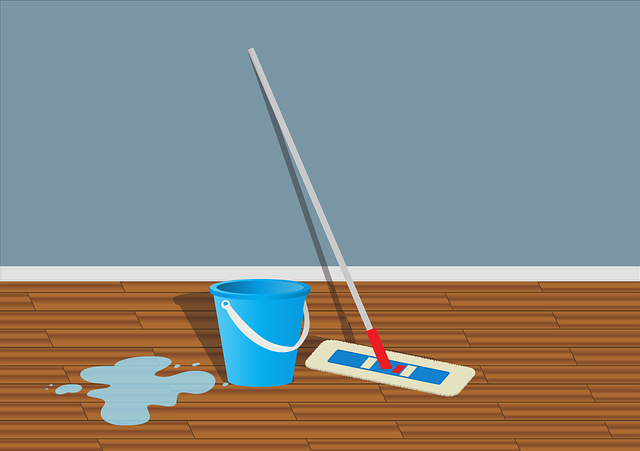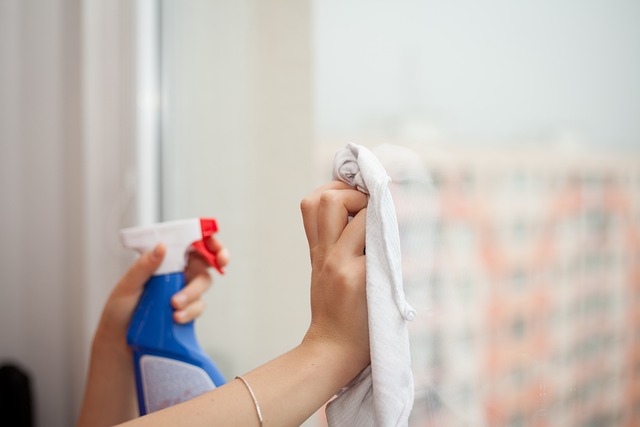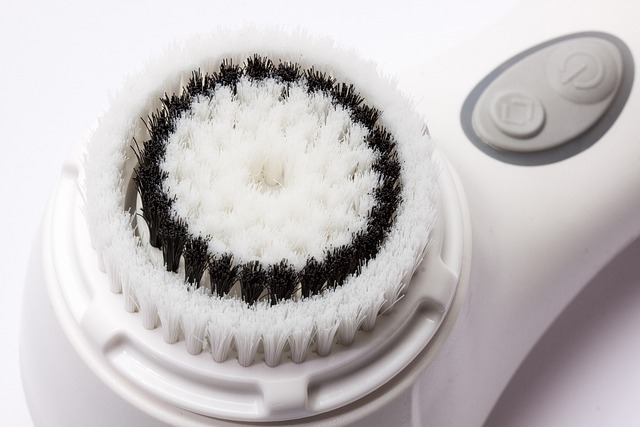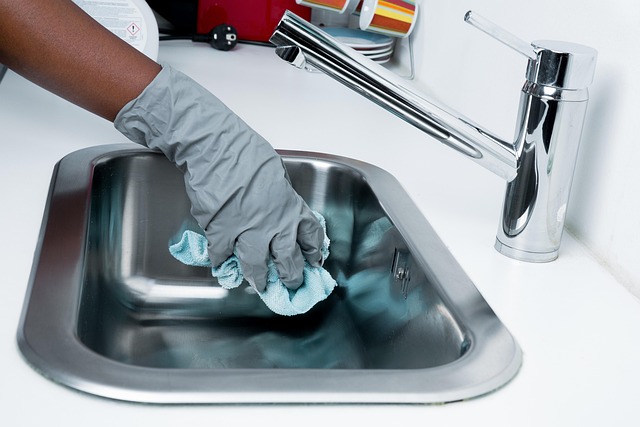Understanding different tile floor types (ceramic, stone, vinyl, porcelain) is crucial for effective cleaning using specific tools like vacuums, brooms, mops, and steam cleaners. Follow best practices: begin with meticulous vacuuming and sweeping, choose suitable cleaning solutions (neutral pH for ceramic/porcelain), spot clean promptly with tailored solutions like baking soda or vinegar, steam mop for deep disinfection, and maintain regularly through daily sweeping, weekly deep cleaning, sealing annually, and prompt spill cleanup using appropriate tools. Prioritize safety by wearing protective gear and testing cleaners on small areas. Professional services are recommended for heavily trafficked areas and high-moisture environments.
Keeping your home or office tile floors sparkling clean is essential for a hygienic and aesthetically pleasing environment. This comprehensive guide uncovers the best methods for cleaning tile floors, addressing various types and considerations. From understanding floor types to choosing effective cleaning solutions and mastering spot cleaning techniques, we provide valuable insights. Learn about steam mopping for deep disinfection, maintenance tips, and when to opt for professional services. Discover safety precautions and expert advice for achieving clean, durable tile floors.
Understanding Your Tile Floor Types

Knowing your tile floor types is crucial when determining the best methods for cleaning them effectively. Ceramic tiles, for instance, are highly durable and water-resistant but can be sensitive to harsh chemicals. Stone tiles like marble or granite require specialized care due to their porosity, necessitating pH-neutral cleaners to prevent etching. Vinyl floors need gentle cleaning agents as they are more susceptible to damage from abrasive materials.
Porcelain tiles, known for their strength and versatility, can handle stronger detergents but should be rinsed thoroughly to avoid residue buildup. Different floor types demand distinct approaches—from sweeping and mopping to steam cleaning or using specialized tools like scrubbers or vacuums. Understanding these nuances ensures your tile floors remain in pristine condition, enhancing the overall aesthetics of both homes and offices.
Vacuuming and Sweeping Before Deep Cleaning

Before tackling the deeper cleaning process, it’s essential to start with a thorough vacuuming and sweeping session. This initial step is crucial for removing loose dirt, dust, and debris that might have accumulated on the tile floor over time. Using a vacuum cleaner with a suitable attachment ensures that even hard-to-reach areas are cleaned efficiently. Pay close attention to corners, edges, and beneath furniture, as these spots often gather grime.
For optimal results, sweep the floor afterward using a soft-bristled broom to dislodge any remaining particles. This simple yet effective method sets the stage for more comprehensive cleaning, ensuring that your tile floors are in pristine condition. Remember, following these best methods for cleaning tile floors will contribute to maintaining a healthy and aesthetically pleasing environment both at home and in offices.
Choosing the Right Cleaning Solutions

When it comes to cleaning tile floors, selecting the right cleaning solutions is a crucial first step. The best methods for cleaning tile floors involve using products designed specifically for their material and finish. For ceramic and porcelain tiles, look for neutral pH cleaners that won’t damage or discolor the surface. Avoid abrasive detergents which can scratch delicate finishes. Additionally, consider the traffic and soiling levels in both homes and offices to choose solutions with suitable potency.
For a deep clean, using a combination of warm water, mild detergent, and a microfiber mop is an effective approach. For tough stains, invest in a tile floor cleaner that contains enzymes or acids to break down grime. Remember, for best results, test any new cleaning solution on a small, inconspicuous area first to ensure compatibility with your tiles.
Effective Spot Cleaning Techniques

When it comes to tile floor cleaning, spot cleaning is a crucial aspect that often gets overlooked. The best methods for cleaning tile floors involve using the right tools and products tailored to the specific stain or dirt. For instance, for grease stains, an absorbent cloth dampened with a mild detergent or baking soda solution can effectively lift the grime. For more stubborn marks like wine or ink, a mixture of water and white vinegar or a specialized tile floor cleaner is recommended.
It’s important to act swiftly when dealing with spills as soon as possible to prevent deep penetration of stains. Always spot clean from the edge towards the center of the stain to avoid spreading contaminants across the floor. Additionally, using a microfiber mop or cloth ensures efficient absorption and minimal water usage, preserving the tile and grout’s integrity.
Steam Mopping for Deep Disinfection

Steam mopping is one of the best methods for cleaning tile floors, offering a deep disinfection that goes beyond conventional cleaning techniques. The process involves using hot steam to loosen and break down dirt, grime, and even stubborn stains, allowing for an efficient and thorough clean. This method not only leaves your tiles sparkling but also helps eliminate bacteria, viruses, and other harmful microorganisms, making it ideal for both homes and offices.
For optimal results, start by sweeping or vacuuming the floor to remove loose debris. Then, fill your steam mop with water and adjust the settings according to the flooring type. As you move the mop across the tiles, the hot steam will penetrate pores, lifting away dirt and leaving behind a hygienic surface. For particularly stubborn spots, apply a mild, non-toxic cleaner before steaming for enhanced cleaning power.
Maintenance and Care Tips for Longevity

Regular maintenance and care are essential to keep tile floors looking their best over time. The best methods for cleaning tile floors involve a combination of consistent cleaning, sealing, and protection. Daily sweeping or vacuuming helps remove loose dirt and debris, preventing them from settling into the grout lines. Using a mild detergent or pH-neutral cleaner once a week ensures deep cleaning without damaging the tiles or grout.
Additionally, sealing your tile floors annually with a high-quality sealer protects against stains, moisture, and wear. This simple step goes a long way in preserving the beauty and longevity of your tile flooring. Remember, prompt cleaning of spills is crucial to avoid staining, and using appropriate tools like microfiber mops or brushes can make the process more efficient.
Addressing Common Tile Floor Issues

Tile floors, despite their durability, can accumulate various types of dirt and stains over time. Addressing common issues efficiently is key to maintaining a pristine look. One frequent problem is the buildup of grout lines, which require regular cleaning to prevent bacteria growth. Additionally, tile floors in high-traffic areas often face scuffing and etching from footwear, requiring regular sealing to preserve their shine.
The best methods for cleaning tile floors involve a combination of consistent maintenance and suitable products. Regular mopping with a pH-neutral cleaner ensures the removal of everyday grime without damaging the tiles or grout. For more stubborn stains, using a mild acid etch can help, but it should be done sparingly to avoid corrosion. Proper sealing and regular reapplication are essential for protecting tile floors from water damage and stains, ensuring they remain in top condition for years to come.
Professional Cleaning Services: When to Consider

When it comes to maintaining tile floors in homes and offices, many homeowners and business owners turn to professional cleaning services. While regular upkeep with best methods for cleaning tile floors can go a long way, certain situations warrant professional attention.
For instance, heavily trafficked areas, such as lobbies or high-traffic hallways, may require more frequent deep cleaning than what can be achieved through DIY methods. Additionally, tiles in kitchens and bathrooms often face the brunt of moisture and stains, necessitating specialized cleaning techniques to prevent damage and maintain their aesthetic appeal. Professional services have the expertise and tools to tackle these challenges effectively, ensuring your tile floors remain in top condition for longer periods.
Safety Precautions During Tile Floor Cleaning

When employing the best methods for cleaning tile floors, safety should be a top priority to avoid accidents and damage. Always wear protective gear such as gloves and eye protection to shield yourself from harsh chemicals or debris. Ensure proper ventilation in both homes and offices by opening windows or using exhaust fans to prevent the buildup of fumes. This is especially crucial when using stronger cleaning solutions.
Before beginning, test any cleaning products on a small, inconspicuous area first to check for staining or adverse reactions with the tile finish. Avoid using abrasive scrubbers or harsh chemicals designed for other types of flooring as these can damage the grout and tiles over time. Stick to pH-neutral cleaners specifically formulated for tile floors to maintain their longevity and appearance.
